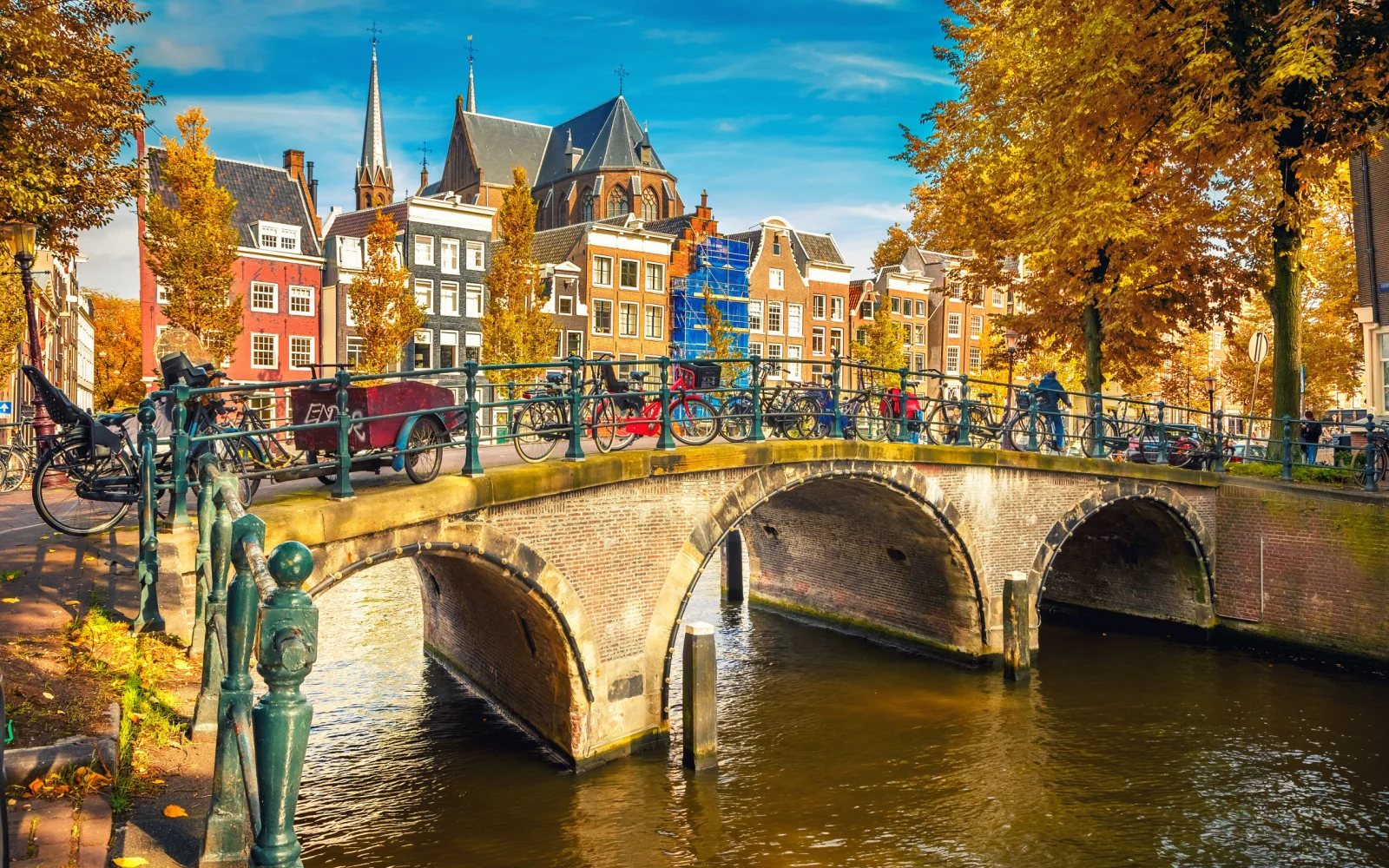For many people, Amsterdam is perennially near the top of the list of their most desired destinations to visit in Europe.
Whether it’s the seemingly endless number of canals, picturesque old houses, “coffeeshops” for tourists, licentious Red Light District, or famously libertine attitude, this city’s many allures have drawn tens of millions of travelers over the years.
In fact, Amsterdam has become so popular with tourists that, in 2018, some 19 million visitors came to this city of just 850,000 permanent residents.
Amsterdam, which, for the previous decade, had been bending over backward to draw in tourists, at this point began to exhibit a vigorous backlash against certain types of visitors, culminating in a well-publicized anti-tourism media campaign in early 2023.
Like Venice (another city where a majority of longtime residents have either left or become overwhelmed by the number of tourists), you could say that the city has a “love/hate relationship” with those who travel there.
But don’t worry — we think that you should still go.
After all, your dollar stretches pretty far once you’re over there. Read on to learn what a trip to Amsterdam costs, including the average prices of hotels, flights, and more. Let us be your guide!
Average Trip to Amsterdam Cost in 2024
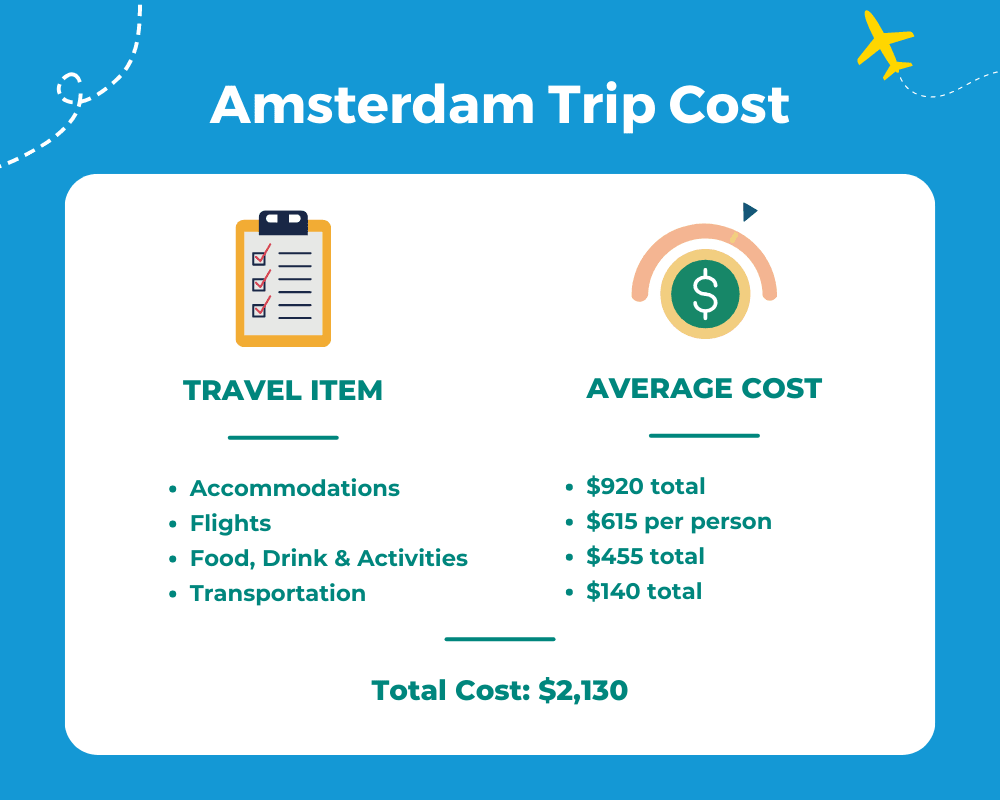
An average seven-day vacation in Amsterdam will cost around $2,130. This can be broken down as follows:
- Average Accommodation Cost: $920
- Average Flight Cost: $615
- Food, Drinks & Activities: $455
- Transportation: $140
- Total Cost: $2,130
Of course, these figures assume one has booked average-priced accommodation and isn’t visiting more than one premier tourist attraction per day.
If you desire to travel to Amsterdam, know that the best time of year to visit is the spring or fall, when the weather is still good but not too hot.
But be aware that while there may be an ideal time to visit Amsterdam weather-wise, there will always be loads of tourists in the city year-round.
In fact, when the weather is good, there can be so many tourists in some of the more popular sections of the city that they have trouble staying on the sidewalks or fitting through the old narrow streets and alleys.
Therefore, consider yourself warned regarding traveling to Amsterdam in the summer!
Amsterdam Trip Cost: Average by Item
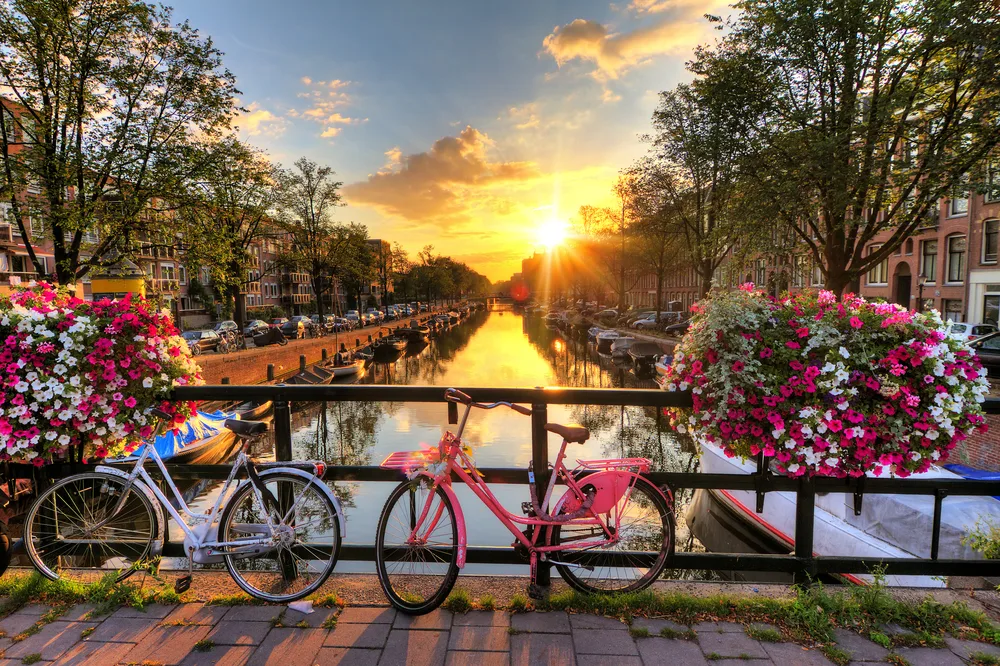
Dennis van de Water/Shutterstock
Accommodation Costs
Hotels in Amsterdam cost an average of $131 per night, while a four- or five-star property might run $333 per night.
Because Amsterdam has so many tourists, some of the more spontaneous visitors don’t book a hotel ahead of time and are conned into staying in illegal properties at too-high prices by “hotel runners” who frequent the city’s central train station and downtown areas.
Therefore, as with flights (see below), hotel stays should be booked in advance — especially if you’re traveling between April and October.
In these cases, you should ideally make reservations at least three months prior to when you’re staying. Because Amsterdam is so popular with young people, there are many low-cost options for accommodation.
A budget hotel can cost $66 per night, while a youth hostel (of which there are many, and most are backpacker-friendly) can cost $25 per night. Bear in mind that camping in public places or parks is illegal, so this is not an option.
It should be noted that, as with many Western European cities, the number of Airbnb/VRBO and other vacation home rental/home-stay properties in Amsterdam has had the effect of driving up prices for residents and distorting the local real estate market.
In order to combat this, the city has enacted some of the toughest regulations regarding vacation home/home-stay rentals anywhere in the world.
Accordingly, this means that any such properties you do see listed can be very, very expensive; prices for these can average $600 per night, although there are sometimes listings in the $100-$150 per night range.
Another alluring possibility for accommodation is renting or staying on one of the many houseboats that dot the city’s canals. Prices for these start at just $118 per night.
Flight Costs
Because Amsterdam is such a popular place to visit and because it’s located in the western part of Europe, finding a relatively cheap flight to the city shouldn’t be difficult.
Recent roundtrip flights from NYC on JetBlue averaged $475, and we’ve seen prices as cheap as $180 on other airlines. Of course, a lot depends on when you’re traveling and when you book your tickets.
As with many popular European destinations, it’s recommended that you book at least three weeks to four months in advance of when you’re traveling. The high tourist season is the summer (July and August [especially August]), whereas the cheapest month to fly to Amsterdam is February.
Airlines sometimes have flash sales on tickets to Amsterdam; look for these in the spring. Because Amsterdam is itself a common layover or stopover city, non-direct flights to it won’t necessarily save you money.
One last tip is that when you arrive at Amsterdam’s Schiphol Airport, you should watch out for unlicensed taxi drivers, who may offer you a much lower fare than what they’ll try to charge you at the end of a trip.
Also, don’t pay your driver until all of your luggage is sitting outside the cab. Note that a taxi ride from the airport to the city can cost up to $90; the train or the bus are better bets at $7.
Food, Drink & Activity Costs
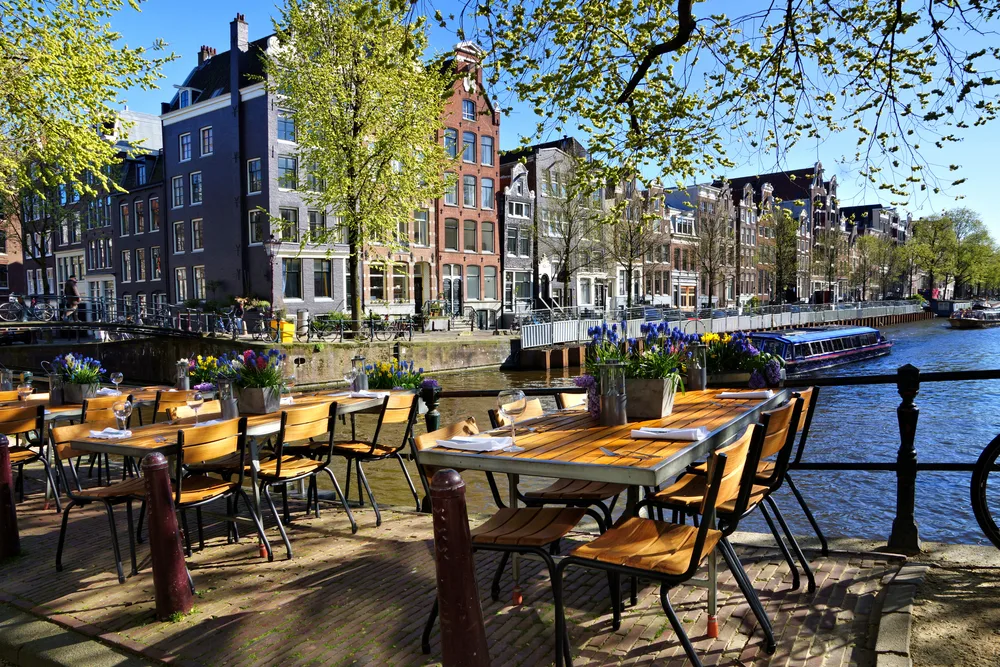
JeniFoto/Shutterstock
Food costs in Amsterdam aren’t that different from those in a large American city. You should likely budget about $35 per day for food if you plan to eat in restaurants, whereas buying food from supermarkets will cost much less.
Drinks are moderately expensive in Amsterdam, with a glass of beer costing about $7 and a glass of wine about $6 at a bar or restaurant. For the cheapest drinks, try supermarkets and corner stores.
Amsterdam is the home of Heineken beer, and the brand has its own Heineken Experience tours of its brewery for visitors. Amsterdam is famous for its museums.
The best-known museums are the Rijksmuseum, the Stedelijk Museum, the Van Gogh Museum, the Scheepvaartmueum (National Maritime Museum), and the Anne Frank House.
You can book tickets for most of these museums online (admission to each museum is roughly $25) or buy an “I Amsterdam” pass (see below) and get access to most of them as well as transport through the city.
Of course, not everyone is coming to Amsterdam to go to museums and see art. One of the biggest reasons that many tourists visit the city every year is to access the substances that are sold in its “coffeeshops.”
Amsterdam has a reputation for legally selling some of the world’s strongest marijuana at these cafés (most of which actually do serve cappuccinos and espressos, as well as juices and teas).
If this is one of the reasons you came to Amsterdam, be aware that there are a bunch of rules and guidelines associated with frequenting these establishments (for more on the rules, see our cautions below in the “Things to Know” section.)
The first rule is that you should have an ID to prove that you’re 18 years old or older. The second rule is that you shouldn’t purchase more than five grams per person (each gram costs roughly $15) per visit.
In fact, you should be very careful about how much you buy (this especially applies to the marijuana-laced snacks/edibles) due to the aforementioned potency of what’s being sold.
Transportation Costs
Amsterdam has some of the best public transportation in the world, so don’t be shy to give it a try while you’re there.
You can buy several different types of passes that entitle you to unlimited rides on the city’s GVB buses (including the airport express buses), trams, metro system, and even (optionally) some regional trains.
A pass valid for one hour costs about $5, while a pass valid for 24 hours is about $10.
The “I Amsterdam” card gives you unlimited rides on the GVB system, plus free or discounted access to many of the city’s museums and other attractions, as well as a free one-hour canal cruise and a 24-hour bicycle rental.
You can choose the number of days the card is valid for. A card that’s valid for two days costs about $95, while one that’s valid for five days costs $140.
Each pass or card has an embedded chip that you hold up to a reader or a gate (you should hear a beeping sound) marked “Kaart hier” at stations or on transport vehicles when you enter and exit.
Note that the city’s GVB ferries are free for everyone and don’t require tickets or passes. Be sure when you’re crossing streets to look out for buses or trams traveling in BOTH directions.
Every year, people are killed in bus and tram accidents in Amsterdam; don’t become a statistic! Another mode of transport to watch carefully (but in different ways) is taxis. Amsterdam’s taxi prices are some of the highest in the world.
Different taxi companies have different rates, but the average fare is about $2.50 per kilometer driven, plus a base charge of $3.50, plus 50 cents per minute of waiting time.
Taxi drivers in Amsterdam are known to be unscrupulous and take advantage of tourists.
To protect yourself, always take a taxi that sports blue license plates, a price list that’s visible both inside and outside the cab, a driver’s pass on the dashboard, and an “exemption card” on the inside of the front windshield on the passenger’s side.
This latter document allows drivers to drive in restricted lanes, such as those used by trams and buses, so they can operate much faster on the city’s streets.
A much cheaper way to get around Amsterdam is riding a bicycle. You can rent a bike in the city for about $12 per day.
Bikes are the most common form of transport, and almost all of Amsterdam’s residents are extremely pro-bike. But be sure not to walk in bicycle lanes and paths, as some “kamikaze”-type cyclists actually speed up when they see someone in their way instead of slowing down.
If you do rent a bike, be careful about following all traffic laws, not biking in pedestrian areas, using lights at night, and not getting your tire stuck in the tram tracks in the street.
While it’s possible to rent a car in Amsterdam, the city’s narrow streets, traffic, extreme lack of parking, and other more popular methods of transportation discourage it.
In the end, parking, driving, and fueling a car may be far more trouble than it’s worth, but if you do insist on renting one, the cost should be around $54 per day.
Things to Consider
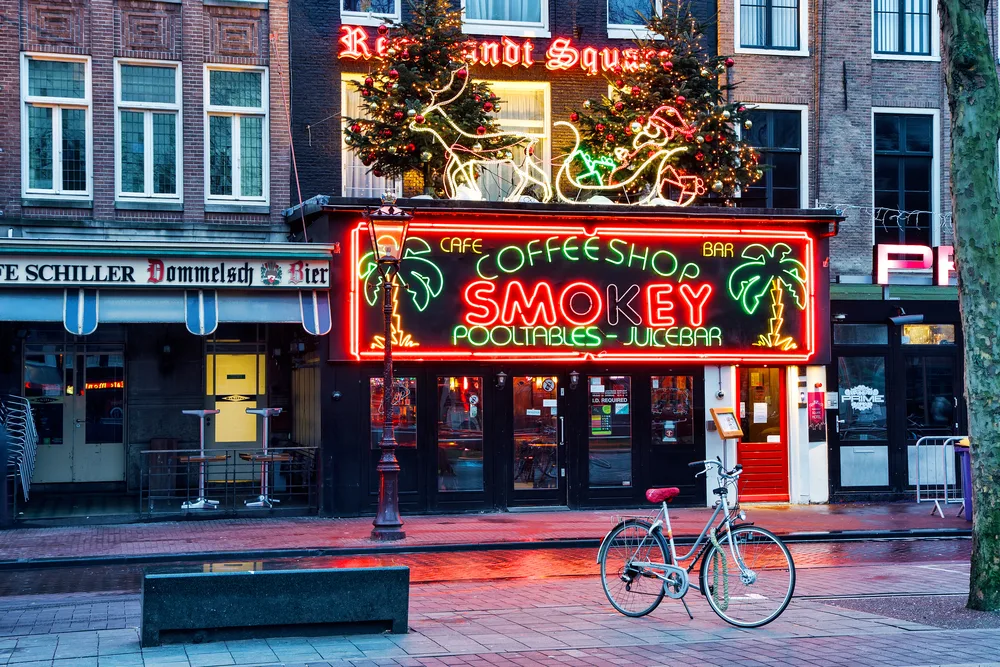
AMSTERDAM, NETHERLANDS – JANUARY 06: Coffeeshop Smokey is a cannabis coffee shop located on the biggest square in Amsterdam, Rembrandt Square/Steven Bostock/Shutterstock
Yes, marijuana can legally be smoked in a coffeeshop. This doesn’t mean all drugs are legal in Amsterdam. Smoking marijuana in public outside of coffeeshops (such as on the street or in parks) is illegal.
Buying and selling other/hard drugs (such as cocaine, ecstasy, heroin, etc.) is illegal everywhere in the Netherlands. Buying or selling any drugs is also illegal if you, the buyer, or the intended user are under the age of 18.
The same policies generally apply to alcohol; alcohol should generally be consumed in bars or restaurants; public consumption outside of these places and terraces or parks is against the law. Note also that tobacco can only be smoked in private, and not in bars or restaurants.
Some other considerations:
- If you do buy anything in a coffeeshop, always follow the advice of the coffeeshop staff and/or any accompanying instructions (particularly regarding amounts to consume in one sitting).
- While you may be offered drugs on the street or in bars or clubs, it’s illegal to buy them, but also know that much of what’s being sold is fake (and may even be harmful).
- While buying fake drugs may not be illegal, you will have very little recourse in terms of getting your money back if you do this.
- Beware of shops selling overpriced cheese and/or pastries made with Nutella. These are generally tourist traps and are not frequented by locals.
- There are roughly 600,000 bicycles in Amsterdam. Every year, some 80,000 are stolen. Be wary if someone wants to sell you a bicycle on the street. Some of these sellers may be undercover police officers. If you buy a stolen bike, you can be fined.
- In general, tipping 5-10% is recommended for restaurants, bars, and services, but don’t feel compelled to tip if you receive poor service.
- Do not litter, vomit in the street, or use doorways or alleys as a toilet. Instead, use trash cans and restrooms like a civilized person. Fines for these bad behaviors are high, and they must be paid on the spot; otherwise, you can be hauled off to jail!
- Do not attach a “love lock” to one of the city’s many antique bridges and toss the key into the canal below. Yes, this may seem like a romantic ritual, but every six weeks, the city has to employ workers to cut off all the locks, which damage the bridges.
- Don’t wander around staring at a map or a phone, looking like you’re lost. Whether it’s in the Red Light District (see above) or anywhere else, this makes you look like a target.
- Beware of anyone who approaches you (even if they’re in what appears to be a uniform) who offers to take you somewhere, wants to pose with you for a photo, wants to give you a “free cookie,” or wants to “check your money” to make sure you’re not spreading counterfeit notes.
- Pickpockets are known to frequent tourist-dense areas and parts of the public transit system, so keep an eye on your belongings, and don’t be easily distracted.
Frequently Asked Questions

V_E/Shutterstock
What is not allowed in Amsterdam?
Beyond certain drugs and prostitution (but not street prostitution, which is illegal), Amsterdam is much like many other European cities in terms of what’s legal and not legal.
Don’t let the attitudes or behavior of other tourists convince you otherwise. The city’s authorities have long since started cracking down on illicit activities, and it’s not unheard of for tourists who behave badly to spend a night in jail.
What currency is used in Amsterdam?
Like most (but not all) places in Europe, Amsterdam uses the Euro. The best place to exchange your money for Euros is your local bank at home before you leave.
That said, it’s wise not to carry large amounts of cash and/or valuables. Bear in mind that some neighborhoods of the city are safer for tourists than others.
Are Amsterdam residents friendly to tourists?
Generally speaking, Amsterdam residents are welcoming and friendly toward visitors. Notwithstanding antagonism toward extreme “party tourists,” as mentioned previously, the city’s residents are open to visitors who are appreciative of the city’s history, heritage, and cultural offerings.
Do people in Amsterdam speak English?
Yes, most Amsterdam residents speak English, in addition to Dutch, and often other languages as well.
Can I rent a boat to travel along the canals?
Yes, you can easily rent boats to travel along the many canals of the city. A two- or three-hour boat rental for up to six people costs about $100. Afternoon and evening rentals can be slightly more expensive, and music-generating devices are often not allowed.
Be sure to travel at 6 kilometers per hour or less, stay to the right when passing other boats or at intersections, and remember that swimming in the canals is strongly discouraged, as they’re polluted with untreated water and bacteria.
So, What Does a Trip to Amsterdam Cost?
| 🛎️ Average Accommodation Cost | $920 total |
| ✈️ Average Flight Cost | $615 per person |
| 🍽️ Food, Drink & Activities | $455 total |
| 🚕 Transportation | $140 total |
| 💲 Total Cost | $2,130 |
Once again, your costs for a trip to Amsterdam can vary widely based on where you stay and what you do while you’re there, but it’s wise to use figures of between $90 and $277 per day for a budget.
Buying an “I Amsterdam” card for your stay can definitely save you money and introduce you to much of the city’s culture. Picking up a guidebook to the local hotspots, attractions, and newer additions to the city is also recommended.
So, with so much to see and do, what are you waiting for — book your trip today and experience for yourself all that Amsterdam has to offer. Happy travels!



